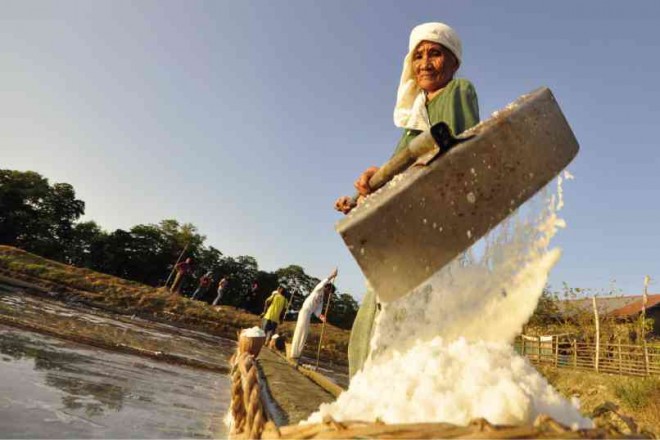Extreme heat good news for salt farms

AN OLD WOMAN working in a salt farm in Dasol, Pangasinan province, takes advantage of the intense heat to harvest salt from seawater in several hectares of beds. WILLIE LOMIBAO / INQUIRER NORTHERN LUZON
DASOL, Pangasinan—This summer’s punishing heat may have caused inconvenience and discomfort to many, but salt farmers in this western town in Pangasinan province have been benefiting much from it.
Eugene Caberto, who tends a salt farm in Barangay (village) Hermosa here, said the hot weather had doubled farm production this summer compared to last year’s. They harvest every day because water evaporates faster from the salt beds, he said.
Salt is produced using water from the West Philippine Sea. The seawater is stored in an impounding pond and released to flood the tiled shallow salt beds in the farm.
Through the heat, the salty water is left to evaporate, leaving behind salt crystals, which are raked, harvested and stored in warehouses for processing.
According to the Philippine Atmospheric, Geophysical and Astronomical Services Administration (Pagasa) branch in Dagupan City, the hottest temperature this year in Pangasinan was recorded on May 17 at 37.5 degrees Celsius. Higher temperatures could still be experienced until the end of summer in the first week of June, said Virginia Bracia, Pagasa weather specialist.
Caberto said the salt farm closed in April last year when rains began to fall. But with the extended summer this year, it may have to continue producing salt until mid-June, he said.
“After that, these salt beds will become fish ponds again,” he said.
In the neighboring town of Infanta, Mayor Percival Mallare said salt farmers also produced more salt this summer because of the favorable weather condition. At least 450 metric tons of salt have so far been processed this summer, he said.
More raw salt have been available this year, said Orlan Norico, 50, a salt processor in Barangay Cato in Infanta. These are bought, refined and cooked in large vats, he said.
His cogon-roofed processing plant, which has four large vats and rice husk as fuel, can produce at least 30 sacks of refined salt in a month. He said he makes a profit of P30 for every sack.
Traders from Metro Manila come here to buy salt.
While the heat contributed to the increase in income of salt farmers, the lack of water has been disadvantageous for rainfed farms, Mallare said.














